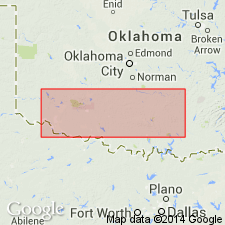
- Usage in publication:
-
- Headquarters granite
- Modifications:
-
- First used
- Dominant lithology:
-
- Granite
- AAPG geologic province:
-
- South Oklahoma folded belt
Taylor, C.H., 1915, Granites of Oklahoma: Oklahoma Geological Survey Bulletin, no. 20, 108 p.
Summary:
First published use; intent to name not stated. Unaltered samples of Headquarters granite show it to be a fine-grained, often porphyritic, brownish-red granite which megascopically reveals dark-flesh-colored to brownish cleavage surfaces of feldspar, rounded grains of colorless, yellowish, or slightly smoky quartz, and small specks of biotite or hornblende. This may be classed as a fine-grained, inequigranular granite. Alters slowly; weathering is accomplished primarily by chemical decay, therefore the weathered surfaces of the exposed boulders are smooth and do not exfoliate. Cut by many systems of irregular fractures. Contains many intrusions of Reformatory granite (new). Younger than the gabbro-anorthosite exposed in the Wichita Mountains; older than Reformatory granite (new). Age is pre-Middle Cambrian [based on the fact that all of the granites are overlain unconformably by the Reagan sandstone which, according to Ulrich (1904), is Middle Cambrian]. Age is Precambrian. Report includes geologic map.
Type locality not designated. Derivation of name not stated, but probably named from Headquarters Mountain, which it comprises, in the Granite area, Greer Co., OK, Wichita Mountains district, S. Oklahoma folded belt province. Shown on the geologic map in the Granite area, Greer Co., OK.
Source: Modified from GNU records (USGS DDS-6; Denver GNULEX).
For more information, please contact Nancy Stamm, Geologic Names Committee Secretary.
Asterisk (*) indicates published by U.S. Geological Survey authors.
"No current usage" (†) implies that a name has been abandoned or has fallen into disuse. Former usage and, if known, replacement name given in parentheses ( ).
Slash (/) indicates name conflicts with nomenclatural guidelines (CSN, 1933; ACSN, 1961, 1970; NACSN, 1983, 2005, 2021). May be explained within brackets ([ ]).

